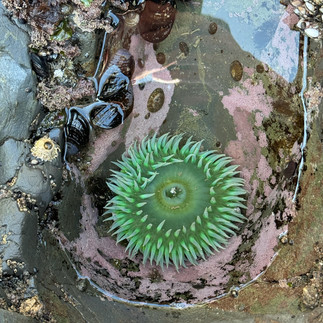
Olympic National Park is fascinating in that it encompasses so many different ecosystems. It is a massive park, covering nearly 1,500 square miles, with beaches, mountains, and rainforests. Over two and a half days, we worked our way around the park to see all the key parts: Lake Quinault, Kalaloch and the coastal areas, the Hoh River Valley, Sol Duc Valley, Lake Crescent, and Hurricane Ridge. We drove a southern route from Seattle, but could easily have done the reverse. We used the Kalaloch Lodge as our base for two nights, with a final night in Sequim on the northeast side of the park to be closer to the ferry at Port Townsend.
In the Lake Quinault area (which straddles the Olympic National Forest and the Olympic National Park), we hiked the the Quinault Rain Forest Nature Trail, which was an excellent introductory hike to the rain forest environment and a good opportunity to stretch our legs on our way to Kalaloch. We also made the short hike to see the world's largest Sitka spruce tree (above left photo). About 35 minutes from Lake Quinault, the Kalaloch park lodge provided a beautiful place to stay, as it was right on the coast. The sunset photo above was taken from the grounds of the lodge. Nearby is the Tree of Life, a large Sitka spruce that is literally hanging on to the coast, with much of its roots exposed due to erosion (above right photo).
For our second day, we focused on the Hoh Rain Forest and coastal areas of the park. The Hoh River Valley is a temperate rain forest that receives upward of 140 inches of rain a year, creating a lush plant environment as well as trees densely covered with moss. We did three enjoyable hikes in the area: Hall of Mosses Trail (0.8 miles) (left photo above), the Spruce Nature Trail (1.2 miles), and the Hoh River Trail to Mineral Creek Falls (5.5 miles). We saw several Roosevelt Elks right off the trail (middle photo above). We also saw many great examples of trees growing out of "nurse logs," which are fallen, decaying trees that provide nutrients for sprouting saplings. The most unique example we saw were trees that were growing from the root cluster of a fallen log (right photo above); those trees were growing off the top of the root cluster!
Afterwards, we checked out the town of Forks, then headed to Rialto Beach, where we did the 3.3-mile hike to Hole-in-the-Wall, a sea-carved arch, which can only be reached around low tide (top middle photo). The area near Hole-in-the-Wall includes rocky tidal pools, which were fascinating to watch. We were able to spot starfish, sea anemone, sea snails, mussels, and other small sea creatures in the pools. The hike was challenging, as the beach is composed of small pebbles and cobbles, sediment that was deposited by glaciers during the ice age. The beach also has hundreds of bleached fallen trees at the edge of the shoreline and several rock formations or sea stacks that were beautiful to see in the surf.
During our final day at Olympic National Park, we covered the northern side of the park. We started in the Sol Duc Valley and hiked the Sol Duc Falls Trail (1.6 mile out and back; top left and middle photos). Our next stop was Lake Crescent, where we hiked the Marymere Falls Trail. The lake, which was carved by a glacier, is stunningly clear and a very deep blue color. Our son Kyle decided he wanted to run the 4.1-mile Mount Storm King Trail, which also starts in the Lake Crescent Lodge area and is considered a highly challenging route. He is a rock-climber so the hike did not phase him (although he said the hike got a little "technical" at the top where you need to use ropes to help you climb up--the photos above attest to that!). He completed that trail and then ran the Marymere Falls Trail in about 90 minutes total. His photos of the views from the top were beautiful. Our final stop in Olympic National Park was Hurricane Ridge (middle right and bottom row photos), which has a fantastic view of the mountain range. There was still snow at the top of the ridge area, but it was easy to make our way around the overlook area, where we saw an adorable hoary marmot and several black-tailed deer.

In terms of brew pubs, we stopped at Barhop Brewing and Artisan Pizza in Port Angeles for an IPA and porter and a delicious sourdough crust pizza and Peninsula Taproom in Sequim, where we were able to meet up and have a delightful evening with our friend Karen Bondurant.









































Thanks for this great summary. We are visiting this Park in August and appreciate your insights and ideas.